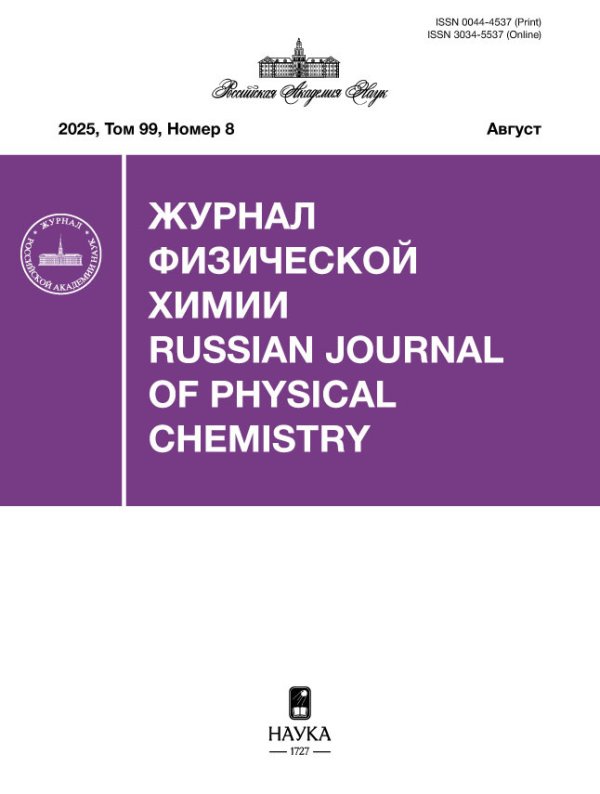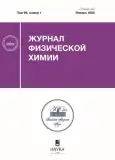Synthesizing metal-organic UiO-66 framework in microwave fields based on polyethylene terephthalate waste for adsorptive removal of tartrazine food dye from aqueous solutions
- Authors: Vergun V.V.1, Vedenyapina M.D.1, Kulaishin S.A.1, Chernyshev V.V.2,3, Tkachenko O.P.1, Nissenbaum V.D.1, Isaeva V.I.1
-
Affiliations:
- N. D. Zelinsky Institute of Organic Chemistry of Russian Academy of Sciences
- A. N. Frumkin Institute of Physical Chemistry and Electrochemistry of the Russian Academy of Sciences
- M. V. Lomonosov Moscow State University
- Issue: Vol 99, No 1 (2025)
- Pages: 97-106
- Section: PHYSICAL CHEMISTRY OF SOLUTIONS
- Submitted: 01.06.2025
- Published: 17.04.2025
- URL: https://innoscience.ru/0044-4537/article/view/681872
- DOI: https://doi.org/10.31857/S0044453725010099
- EDN: https://elibrary.ru/EIIWJW
- ID: 681872
Cite item
Abstract
The sample of metal-organic UiO-66 framework (Zr6O4(OH)4bdc, bdc = benzene-1,4-dicarboxylate/terephthalate), which is a promising adsorbent of persistent organic pollutants from aqueous medium, is obtained by the original method in the medium of unconventional “green” solvent, triethylene glycol (TEG), under conditions of microwave activation of reaction mass at atmospheric pressure according to one-step approach. PET-UiO-66 material is synthesized using polymer waste, viz. recycled polyethylene terephthalate (PET), as a source of organic linker (terephthalic or benzene-1,4-dicarboxylic acid, H2bdc) for framework formation. Its adsorption activity is first studied in the adsorption removal of tartrazine food dye (E-102) from aqueous solutions. It is found that the kinetics of the adsorption process obeys the pseudo-second-order model, and its thermodynamics corresponds to the Langmuir model.
Full Text
About the authors
V. V. Vergun
N. D. Zelinsky Institute of Organic Chemistry of Russian Academy of Sciences
Author for correspondence.
Email: polubrat@mail.ru
Russian Federation, Moscow
M. D. Vedenyapina
N. D. Zelinsky Institute of Organic Chemistry of Russian Academy of Sciences
Email: polubrat@mail.ru
Russian Federation, Moscow
S. A. Kulaishin
N. D. Zelinsky Institute of Organic Chemistry of Russian Academy of Sciences
Email: polubrat@mail.ru
Russian Federation, Moscow
V. V. Chernyshev
A. N. Frumkin Institute of Physical Chemistry and Electrochemistry of the Russian Academy of Sciences; M. V. Lomonosov Moscow State University
Email: polubrat@mail.ru
Russian Federation, Moscow; Moscow
O. P. Tkachenko
N. D. Zelinsky Institute of Organic Chemistry of Russian Academy of Sciences
Email: polubrat@mail.ru
Russian Federation, Moscow
V. D. Nissenbaum
N. D. Zelinsky Institute of Organic Chemistry of Russian Academy of Sciences
Email: polubrat@mail.ru
Russian Federation, Moscow
V. I. Isaeva
N. D. Zelinsky Institute of Organic Chemistry of Russian Academy of Sciences
Email: polubrat@mail.ru
Russian Federation, Moscow
References
- Chaturvedi P., Shukla P., Giri B.S. et al. // Environmental Res. 2021. T. 194. P. 110664.
- Ezzatahmadi N., Marshall D.L., Hou K. et al. // J. Environ. Chem. Eng. 2019. V. 7. P. 102955.
- Tang J., Wang T., Xia H. et al. // Sustainability. 2024. V. 16. P. 2042.
- Ariza-Tarazona M.C., Siligardi C., Carrėon-Loˇpez H.A. et al. // Marin. Pollut. Bull. 2023. V. 193. P. 115206.
- Yang R.X., Bieh Y.T., Chen C.H. et al. // ACS Sustainable Chem. Eng. 2021. V. 9. P. 6541.
- Kartik S., Balsora H.K., Sharma M. et. al. // Therm. Sci. Eng. Progr. 2022. V. 32. P. 101316.
- Ferreira M.M., Silva E.A., Cotting F. et. al. // Corros. Eng. Sci. Technol. 2021. V. 56. P. 199.
- Kaur G., Uisan K., Ong K.L. et. al. // Cur. Opin. in Green and Sust. Chem. 2018. V. 9 P. 30.
- Yang R.X., Bieh Y.T., Chen C.H. et. al. // ACS Sustainable Chem. Eng. 2021. V. 9. P. 6541.
- Rowsell J.L., Yaghi O.M. // Microporous and Mesoporous Mat. 2004. V. 73. P. 3.
- Ghazvini M.F., Vahedi M., Nobar S.N., et al. // J. Environ. Chem. Eng. 2021. V. 9. P. 104790.
- Ihsanullah. I. // Curr. Opin. Environ. Sci. Health. 2022. V. 26. P. 100335.
- Obeso J.L., Flores J.G., Flores C.V. et al. // Chem. Commun. 2023. V. 59. P. 10226.
- Baumann A.E., Burns D.A., Liu B. et al. // Commun Chem. 2019. V. 2. P. 86.
- Mendes R.F., Figueira F., Leite J.P. et al. // Chem. Soc. Rev. 2020. V. 49. P. 9121.
- Isaeva V.I., Vedenyapina M.D., Kurmysheva A.Y. et. al. // Molecules. 2021. V. 26. P. 6628.
- Cavka J., Jakobsen S., Olsbye U. et al. // JASC Com. 2008. V. 140. P. 42.
- Kazemi A., Moghadaskhou F., Pordsari M.A. et al. // Sci Rep. 2023. V. 13. № 19891.
- Ahmadijokani F., Molavi H., Rezakazemi M. et al. // Prog. Mater. Sci. 2022. V. 125. P. 100904.
- Rego R.M., Kurkuri M.D., Kigga M. // Chemosphere. 2022. V. 302. P. 134845.
- Ramanayaka S., Vithanage M., Sarmah A. et al. // RSC Adv. 2019. V. 9. P. 34359.
- Cao Z., Fu X., Li H. et al. // ACS Sustain. Chem. Eng. 2023. V. 11. P. 15506.
- Shanmugam M., Chuaicham C., Augustin A. et al. // New J. Chem. 2022. V. 46. P. 15776.
- Lo S.H., Raja D.S., Chen C.-W. et. al. // Dalton Trans. 2016. V. 45. P. 9565.
- Dyosiba X., Ren J., Musyoka N.M. et al. // Ind. Eng. Chem. Res. 2019. V. 58. P. 17010.
- Semyonov O., Kogolev D., Mamontov G. et al. // Chem. Eng. J. 2022. V. 431. P. 133450.
- Selahle S.K., Nqombolo A., Nomngongo P.N. // Sci Rep. 2023. V. 13. P. 6808.
- Waribam P., Katugampalage T.R., Opaprakasit P. et. al. // Chem. Eng. J. 2023. V. 473. P. 145349.
- Oymak T., Tokalıoglu S., Cam S. et al. // Food Additiv. Contamin. 2020. V. 37. P. 731.
- Singh H., Goyal A., Bhardwaj S. et al. // Mater. Sci. Eng. 2023. V. 288. P. 116165.
- Качала В.В., Хемчян Л.Л., Кашин А.С. и др. // Успехи химии. 2013. Т. 82. С. 648.
- Кашин А.С., Анаников В.П. // Изв. АН Сер. Хим. 2011. Т. 12. С. 2551.
- Tsyganenko A.A., Filimonv V.N. // J. Mol. Struct. 1972. V. 5. P. 477.
- Ivanov A.V., Kustov L.M. // Russ. Chem. Bull. 2000. V. 49. P. 39.
- Köck E.M., Kogler M., Götsch T. et. al. // Dalton Trans. 2017. V. 46. P. 4554.
- Jung K.D., Bell A. // J. Catal. 2000. V. 193. P. 207.
- Ouyang F., Kondo J.N. // JCS Faraday Trans. 1996. V. 92. P. 4491.
- Cheng X., Zhang A., Hou K. et. al. // Dalton Trans. 2013. V. 42. P. 13698.
- Huang J., Yan Z. // Langmuir. 2018. V. 34. P. 1890.
- Lagergren S. // Sakademiens Handl. 1898. V. 24. P. 1.
- Ho Y.S., Mckay G. // Proc. Biochem. 1999. V. 34. P. 451.
- Zeldowitsch J. // Acta Physicochim. 1934. V. 1. P. 364.
- Langmuir I. // Part I. Solids. 1916. V. 184. P. 102.
- Dippong T., Andrea E., Cadar O. et. al. // J. of Alloys and Comp. 2020. V. 849. P. 156695.
- Srivastava V., Sharma Y.C., Sillanpää M. // Applied Surf. Sci. 2015. V. 338. P. 42.
Supplementary files



















